3 UAS Regulation / Innovation / Safety 2020 / Privacy and Beyond [Hood]
Student Learning Objectives
UAS Regulations keep changing. This chapter is designed to bring drone operators and enthusiasts up to date. This chapter is study only.
Two New FAA Rules That make a Difference
Two long awaited rules from the Federal Aviation Administration (FAA) regarding mandating remote identification (Remote ID) of drones and allow drone operators of “small” drones to fly over people and at night under certain conditions. The majority of following information was taken from the FAA Executive Summary and associated press release issued in December 2020.
As a parting gift to show that 2020 wasn’t all bad, the FAA released two long-awaited rules that will help push the drone industry into the future. The FAA’s ultimate goal is to enable routine drone operations in the same airspace as manned aircraft, but a lot of hurdles have to be cleared before that is possible. Like a game of Chutes and Ladders, many small moves and a couple of big ones are required to reach that goal, and along the way, there is an ever-present danger of sliding backwards. (Kiemen, 2021)
Figure 3.1. Embry-Riddle drone ready to fly by Scott Burgess, Embry-Riddle Aeronautical University. Source: Scott Burgess ERAU
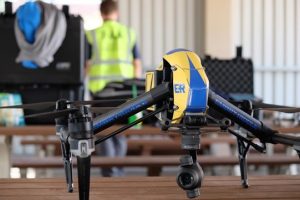
These rules come at a time when drones represent the fastest-growing segment in the entire transportation sector – currently over 1.7 million drone registrations and 203,000 FAA-certified remote pilots. (Administration, 2020) See Figure 3.1
According to the FAA, Remote ID is a major step toward the full integration of drones into the national airspace system. Remote ID provides identification of drones in flight as well as location of their control stations, providing crucial information to our national security agencies and law enforcement partners, and other officials charged with ensuring public safety. Airspace awareness reduces risk of drone interference with other aircraft and people and property on the ground. (Administration, 2020)
Equipping drones with remote ID technology builds on previous steps taken by the FAA and the drone industry to integrate operations safety into the national airspace system. Part 107 of the federal aviation regulations currently prohibits covered drone operations over people and at night unless an operator obtains a waiver from the FAA. The new regulations jointly provide increased flexibility to conduct certain small UAS without obtaining a waiver. (Administration, 2020)
“The new rules make way for the further integration of drones into our airspace by addressing safety and security concerns,” said FAA Administrator Steve Dickson. “They get closer to the day when we will more routinely see drone operations such as delivery of packages.” (Administration, 2020)
As the rules are read and understood, it can be inferred which potential industries these new rules are aimed at effecting (or allowing) to move forward. Examples of such industries include delivery and transit services.
Remote ID
The remote ID Rule applies to all operators of drones that require FAA registrations. There are three ways to comply with the operational requirements:
1: Operate a standard Remote ID drone that broadcasts identification and location information of the drone and control station;
2: Operate a drone with a Remote ID broadcast module (may be separate device attached to the drone), which broadcasts identification, location, and take-off information; or
3: Operate a drone without Remote ID but at specific FAA-recognized identification areas.
(Administration, 2020)
Operations over People and at Night
This rule applies to Part 107 operators. The ability to fly over people and moving vehicles varies depending on the level of risk a small drone operation presents to people on the ground. Operations are permitted base on four categories
These Operations Categories consist of the following:
Category 1 eligible: small, unmanned aircraft must weigh less than 0.55, including everything on board or otherwise attached, and contain no exposed rotating parts that would lacerate human skin. No FAA-accepted Means of Compliance (MOC) or Declaration of Compliance (DOC) required.
Category 2 eligible: small, unmanned aircraft must not cause injury to a human being that is equivalent to or greater than the severity of injury caused by a transfer of 11 foot-pounds of kinetic energy upon impact from a rigid object, does not contain any exposed rotating parts that could lacerate human skin upon impact with a human being, and does not contain any safety defects. Requires FAA-accepted means of compliance and FAA-accepted declaration of compliance.
Category 3 eligible: small, unmanned aircraft must not cause injury to a human being that is equivalent to or greater than the severity of injury caused by a transfer of 25 foot-pounds of kinetic energy upon impact of a rigid object, does not contain any exposed rotating parts that could lacerate human skin upon impact with a human being, and does not contain any safety defects. Requires FAA-accepted means of compliance and FAA-accepted declaration of compliance.
Category 4 eligible: small, unmanned aircraft must have an airworthiness certificate issued under Part 21 of FAA regulations. Must be operated in accordance with the operating limitations specified in the approved Flight Manual or so otherwise specified by the Administrator. The operating limitations must not prohibit operations over human beings. Must have maintenance, preventive maintenance, alterations, or inspections performed in accordance with specific requirements in the final rule. (Administration, 2020)
Figure 3.2 EL PASO, TEXAS – NOVEMBER 20: DroneUp pilot Andrew Holbert prepares to launch a drone to deliver a COVID-19 self-collection test kit to a home, after being ordered from Walmart by a resident, amid a Covid-19 surge on November 20, 2020 in El Paso, Texas. Source: Photo by Mario Tama/Getty Images
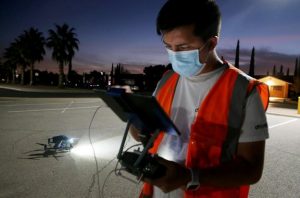
Operating Rules
Operations at Night (See Figure 3.2)
- – Remote pilots in command who wish to conduct small, unmanned aircraft operations at night must complete either the updated initial test or the updated recurrent online training prior to conducting such operations.
- – Additionally, prior to conducting small, unmanned aircraft operations at night, the small, unmanned aircraft must be equipped with anti-collision lights that can be seen for 3 statute miles and have a flash rate sufficient to avoid a collision. These anti-collision lights must be operational.
Operations Over People
- – Category 1 eligible aircraft:
- o Small, unmanned aircraft must weigh less than 0.55, including everything on board or otherwise attached, and contain no exposed rotating parts that would lacerate human skin. Remote pilots are prohibited from operating a small, unmanned aircraft as a Category 1 operation in sustained flight over open-air assemblies unless the operation meets the requirements for standard remote identification or remote identification broadcast modules established in the Remote ID Rule.
(Administration, 2020)
- – Category 2 eligible aircraft:
- o Remote pilots are prohibited from operating a small, unmanned aircraft as a Category 2 operation in sustained flight over open-air assemblies unless the operation meets the requirements for standard remote identification or remote identification broadcast modules established in the Remote ID Final Rule.
- o Requires means of compliance and declaration of compliance by applicant.
- – Category 3 eligible aircraft:
- o Must not operate the small, unmanned aircraft over open-air assemblies of human beings.
- o May only operate the small, unmanned aircraft above any human being if operation meets one of the following conditions:
- The operation is within or over a closed- or restricted-access site and all human beings located within the closed- or restricted-access site must be on notice that a small, unmanned aircraft may fly over them
- The small, unmanned aircraft does not maintain sustained flight over any human being unless that human being is directly participating in the operation of the small, unmanned aircraft; or located under a covered structure or inside a stationary vehicle that can provide reasonable protection from a falling small, unmanned aircraft.
- – Category 4 eligible aircraft:
- o Must have an airworthiness certification issued under Part 21.
- o Must be operated in accordance with the operating limitations specified in the approved Flight Manual or as otherwise specified by the Administrator. The operating limitations must not prohibit operations over human beings.
- o Must have maintenance, preventative maintenance, alterations, or inspections performed in accordance with specific maintenance requirements detailed in the final rule.
- o Remote pilots are prohibited from operating a small, unmanned aircraft as a Category 4 operation in sustained flight over open-air assemblies unless the operation meets the requirements of standard remote identification or remote identification broadcast modules established in the Remote ID Final Rule.
(Administration, 2020)
Figure 3.3 UAV and Drone Solutions monitoring aircraft (Source: AOPA.org)
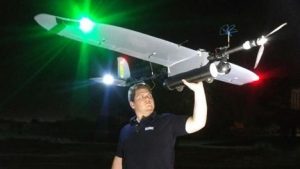
Operations over moving vehicles (See Figure 3.3)
- – Must be Category 1, Category 2, and Category 3, eligible to operate over people, may not maintain sustained flight over moving vehicles; transit operations only.
- – For an operation under Category 1, Category 2, or Category 3, the small, unmanned aircraft, throughout the operation –
- o Must remain within or over closed- or restricted-access sites, and all human beings located inside a moving vehicle within the closed- or restricted-access site must be on notice that a small, unmanned aircraft may fly over them; or
- o Must not maintain sustained flight over moving vehicles.
- – For a Category 4 operation, the small, unmanned aircraft must –
- o Have an airworthiness certificate issued under part 21 of this chapter.
- o Be operated in accordance with the operating limitations specified in the approved Flight Manual or as otherwise specified by the Administrator. The operating limitations must not prohibit operations over human beings located inside moving vehicles.
Figure 3.4. Las Vegas, NV, September 23, 2020. A DroneUp employee prepares a Covid-19 test kit for delivery. (Source: Joe Cerreta, Embry-Riddle Aeronautical University)
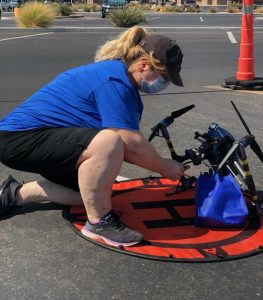
Remote Pilot Knowledge Test Changes (See Figure 3.4)
A remote pilot in command, owner, or person manipulating the flight controls of a small, unmanned aircraft system must:
- – Have in that person’s physical possession and readily accessible the remote pilot certificate with a small UAS rating and identification when exercising the privileges of that remote pilot certificate.
- – Present his or her remote pilot certificate and identification upon request from the FAA, NTSB, TSA, or and Federal, state, or local law enforcement officer.
- – Make available, upon request, to the FAA and document, record, or report required to be kept under FAA regulations.
- – Upon request, must allow the FAA to test or inspect the small, unmanned aircraft system, the remote pilot in command, the person manipulating the flight controls of a small, unmanned aircraft system, and, if applicable, the visual observer to determine compliance with the rule. (Administration, 2020)
Design and production Rules for Manufacturers
- – Some existing Category 1 small, unmanned aircraft may meet the performance-based requirements to be eligible for Category 1 operations over people of this rule beginning the effective date of the rule (Those that have already been produced with propeller guards/shrouds that prevent the blades from causing laceration to human skin upon impact).
- – Manufacturers may bring to market retrofit propeller guards to install on existing small, unmanned aircraft to make them eligible for Category 1 operations over people beginning after effective date of this rule.
- – Some existing small, unmanned aircraft may meet the performance-based requirements to be eligible for Category 2 operations over people of this rule once FAA-accepted MOC and DOC are received.
- – Small, unmanned aircraft may meet the performance-based requirements for Category 2 of this rule upon FAA-Accepted MOC/DOC 9-12 months after the effective date of this rule.
- – Small, unmanned aircraft may meet the performance-based requirements for Category 3 of this rule upon FAA-Accepted MOC/DOC 9-12 months after the effective date of this rule.
- – Category 4 small, unmanned aircraft for operations over people may receive an airworthiness certificate beginning 6-12 months after the effective date of this rule.
Major Changes from Proposed Rule to the Final Rule
- – Category 1 small, unmanned aircraft cannot have any exposed rotating parts that would lacerate human skin.
- – Category 1, 2, and 4 remote pilots are prohibited from operating small, unmanned aircraft in sustained flight over open-air assemblies unless the operation meets the requirements of standard remote identification or remote identification broadcast modules established in the Remote ID Final Rule.
- – Added a Category 4 of small, unmanned aircraft that. Ay be eligible for operations over people and moving vehicles.
- – Allow operations over moving vehicles
- – Remote pilot, owner, or person manipulating the controls must have in their physical possession and readily available their remote pilot certificate.
(Administration, 2020)
What Do These Two Rules Really Mean and Why is it Important?
Some major players in the drone industry are not all that happy with the new rules as they currently stand. The following article excerpt from Sean Hollister has a much different take and makes some interesting points.
Alphabet’s drone delivery company “Wing” still wants drones tracked — but differently
Internet-based tracking is exactly what the FAA had originally intended to do when it first
proposed the Remote ID rules back in December 2019, by the way — before it received a
laundry list of reasons from commenters why internet-based tracking might be problematic and
decided to abandon it. Here are just a few of the ones mentioned:
- The cost of adding a cellular modem to a drone to begin with
- The cost of paying for a monthly cellular data plan just to fly a drone
- The lack of reliable cellular coverage across the entirety of the US
- The cost of paying a third-party data broker to track and store that data
- The possibility of that third-party data broker getting breached
- The possibility of that data broker or network getting DDoS’d, grounding drones in the US
“Personally,[1] I think it’s pretty ridiculous that the FAA felt it had to choose between “everyone has to broadcast their location to everyone within earshot” and “everyone has to pay gobs of money to private industry and trust some data broker with their location,” but the reasons why we aren’t going with internet-based tracking make some sense to me. (Hollister, 2021)
Most proponents of Remote ID technology, including Wing, like to explain that it’s merely a “license plate” for the skies, perhaps nothing more intrusive than you’d already have on your car. Here’s Wing (See Figure 3.5) on that:
This allows a drone to be identified as it flies over without necessarily sharing that drone’s complete flight path or flight history, and that information, which can be more sensitive, is not displayed to the public and only available to law enforcement if they have proper credentials and a reason to need that information. (Hollister, 2021)
But the thing about license plates is, traditionally, you have to be within eyeshot to see them. You’d have to be physically following a car to track it. That’s not necessarily true of a broadcasting transmitter, and it’s potentially far less true of an internet-based solution like the one Wing seems to wish the FAA had offered instead. Naturally, it depends on who owns the internet-based solution and how much you trust them and their security. (Hollister, 2021)
Either way, it’s going to be a while before we find out how secure or vulnerable, how broad or narrow these Remote ID broadcasts are truly going to be. That’s because the FAA’s final rule doesn’t actually mandate what kind of broadcasting tech drones will be required to use: companies have the next year and half to figure that out, and they have to submit it to the FAA for approval. The FAA is also clear that broadcast Remote ID is just a first step, an “initial framework,” suggesting that internet-based Remote ID might still be an option in the future. (Hollister, 2021)
Figure 3.5 Image: Wing. (Source: https://www.theverge.com/2021/1/1/22209558/google-wing-faa-drone-remote-id-broadcast-rule-privacy-security)
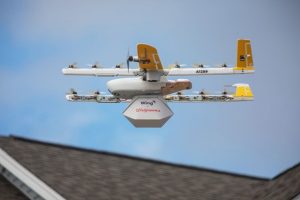
Drone Privacy Laws Around the World
The following sub sections are part of an in-depth survey from Surfshark regarding drone privacy laws around the world. The great thing about the study is that it drills down into a region-by-region analysis.
As the use of drones expands around the world — according to the Federal Aviation Administration, there are currently 1.7 million drones registered in the United States alone — lawmakers have been faced with new and complex regulatory challenges to protect the privacy of ordinary citizens. The increased prevalence of drones has raised the prospect of pervasive surveillance by governments, companies, and individuals, and lawmakers are struggling to keep up with the advancing technology. (SurfShark, 2021)
And while at least 143 countries have enacted some form of drone-related regulation, many experts contend that current drone regulation is insufficient to deal with the threat of widespread surveillance. Drone laws around the world range from outright bans of the technology to relatively unrestricted flight, but most legislation focuses on how the drone is being operated — and does not address nuances related to privacy. Many of the privacy threats that have lawmakers concerned are speculative and rely on the technology of tomorrow — making it difficult to pass privacy-specific legislation today. In the meantime, lawmakers have been able to pass laws concerning drone operation, which are a first step to “privacy by design” legislation, restricting where and how a drone can be flown to minimize opportunities to violate privacy in the first place. To support the effort to establish an international regulatory framework for drone legislation, we looked at drone operation laws in over 200 countries around the world. (SurfShark, 2021)
Lawmakers around the world have responded to the growing use of drones in various ways. While some countries, such as Cuba, Iraq, Iran, and Kuwait, have outright banned the use of unmanned aircraft, others have passed legislation allowing for more experimental use of the technology. (SurfShark, 2021)
On every continent, at least one country allows drones to fly what experts term “beyond visual line of sight”, meaning the aircraft can fly to areas beyond the view of the pilot. In Finland, for example, where the home of FAI Drone Racing World Cup is held, pilots can obtain a permit allowing them to pilot drones outside of their view with special first-person view goggles. To see how drones are being regulated around the world, we compiled data on drone-related legislation for 210 countries. We looked at drone-related legislation for specific countries and analysis of drone-related legislation from sources such as UAV Coach, RAND Corporation, UAV Systems International, and the Library of Congress. (SurfShark, 2021)
We found that drone regulation in each country generally fell into one of seven categories:
- Outright ban
- Effective ban
- Restrictions Apply (such as drone registration or licensing, additional observers required, no commercial usage etc..)
- Visual line of sight required
- Experimental visual line of sight (experiments where drones fly beyond the line of sight are allowed)
- Unrestricted (when flying away from private property and airports, under 500 ft/150metres height and with drones weighing less than 250g)
- No drone-related legislation
We assigned each country a category status based on its legislation as of October 2020.
Europe
Europe currently has some of the most liberal drone regulation of any continent. Although many of the countries in the continent have some form of drone legislation restricting drone usage, these are often in the form of simple operational guidelines.
Drone pilots in Latvia, for example, are required to wear an identifying piece of clothing, such as a hat or a shirt. In Austria, pilots are required to get a license if the drone weighs more than about half a pound and flies above 98 feet. (SurfShark, 2021)
Figure 3.6 EUROPE: Drone Privacy Laws. (https://surfshark.com/drone-privacy-laws)
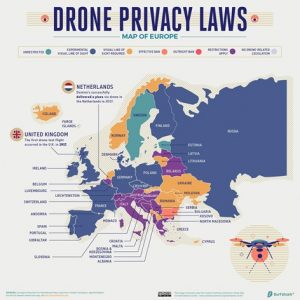
North America
While the bulk of countries around the world require drone pilots to be able to see the UAV at all times, 33% of countries in North America allow for experimental drone flights beyond the line of sight, the largest share of any continent and far above the 22% global average. The large number of countries allowing experimental drone flights may be related to the presence of tech companies like Amazon, Walmart, and DHL, which are researching ways to incorporate drones into their delivery infrastructure and developing methods to ship lightweight packages short distances. Countries with experimental drone legislation include Canada, the United States, the Cayman Islands, Antigua and Barbuda, and other small Caribbean nations. (SurfShark, 2021)
Figure 3.7 NORTH AMERICA: Drone Privacy Laws. (https://surfshark.com/drone-privacy-laws)
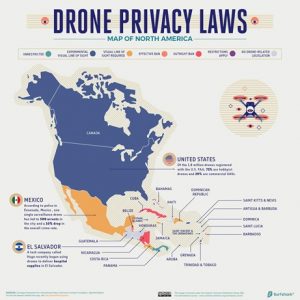
South America
67% of countries with drone-related legislation in South America allow drones to be flown, as long as the aerial vehicle stays within the view of the pilot, the largest share of any continent. No countries in South America have outright or effective bans on drones. But while no countries ban drones, only one country, Guyana, has provisions that allow for flights beyond the line of sight — the fewest of any continent. Other countries in South America have specific drone rules geared towards safety and environmental conservation. In Peru, for example, drones’ flights cannot last longer than an hour. In Ecuador, drones are completely banned on the Galapagos Islands save for approved scientific usage. (SurfShark, 2021)
Figure 3.8 SOUTH AMERICA: Drone Privacy Laws. (https://surfshark.com/drone-privacy-laws)
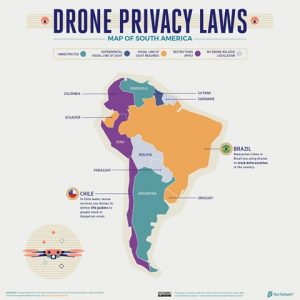
Middle East & Central Asia
21% of countries here with drone-related legislation have outright bans on drones, more than the 11% global share and the second largest share of any continent. Additionally, there are a number of countries with effective bans on drones. In Bhutan, for example, drone flight is only allowed by the government. Overall, 15% of countries in Asia have effective bans on drones, far more than the 8% global average and the largest share of any continent. A small number of countries, however, are beginning to allow for drone flights beyond the line of sight. Japan, for example, is currently developing a licensing system that will allow for drone flights beyond the visual line of sight for government deliveries. (SurfShark, 2021)
Figure 3.9 ME & CA: Drone Privacy Laws. (https://surfshark.com/drone-privacy-laws)
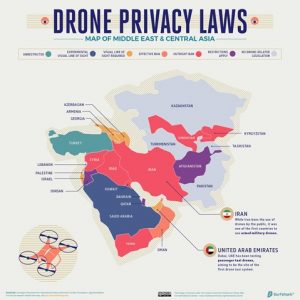
Rest of Asia and Oceania
56% of countries in Oceania have no drone-related legislation, the largest share of any continent. Of the countries that do have drone-related legislation, a majority allow drones as long as pilots stay within the visual line of sight of the drone. No countries have outright bans or effective bans of drones. In Australia and New Zealand, there are provisions for drones to fly beyond the visual line of sight of the pilot. Currently, licenses that permit drones to fly beyond the line of sight are limited among a few small aviation companies. According to the RAND Corporation, licenses for experimental flights beyond the line of sight are easier to obtain in Australia than in the United States. (SurfShark, 2021)
Figure 3.10 OCEANA: Drone Privacy Laws. (https://surfshark.com/drone-privacy-laws)
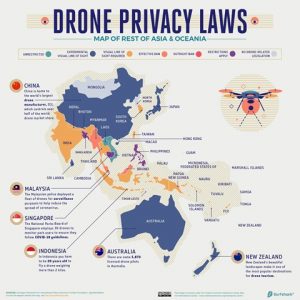
Africa
More than half of all countries in Africa have no drone-related legislation. Of the countries that do have drone-related legislation, 21% have an outright ban on the technology, the largest share of any continent. Another 13% of countries have an effective ban on the technology, the second largest share of any continent. In Egypt, for example, while drones are technically legal with permission from the Civil Aviation Authority, it is very difficult to obtain permission. But while there are obstacles to drone flight in a number of African countries, there are also examples of innovation in the continent. In Ghana and Rwanda, for example, drones are allowed to fly beyond the line of sight to deliver medical supplies to remote villages. Other African countries that allow drones to fly beyond the line of sight include Uganda and Zimbabwe. (SurfShark, 2021)
Figure 3.11 AFRICA: Drone Privacy Laws. (https://surfshark.com/drone-privacy-laws)
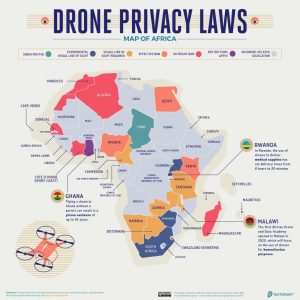
Demand for drone technology shows no signs of slowing down. According to the World Intellectual Property Organization, the number of patents for drone technology is increasing rapidly — growing 34% from 7,076 in 2017 to 9,485 in 2018 alone. As commercial technology for unmanned aerial vehicles continues to advance, it is important for the legislation regulating them to keep up. And until there is some international standard or governing body for the usage of drones established, it’s fascinating to see how the regulation of drones differs from country to country around the world. Keep scrolling down to see the full data from our study, and to check out the law where you live. (SurfShark, 2021)
Methodology & Sources
To see how drones are being regulated around the world, we looked at related legislation for specific countries using sources such as UAV Coach, RAND Corporation, UAV Systems International, and the Library of Congress. We found that drone regulation in each country fell into one of seven categories: outright ban, effective ban, visual line of sight required, experimental visual line of sight (experiments where drones fly beyond the line of sight are allowed), restrictions apply, unrestricted, and no drone-related legislation. We assigned each country a category status based on its legislation as of October 2020. (SurfShark, 2021)
References
Administration, F. A. (2020, December 28). faa.gov. Retrieved from Press Release – US Department of Transportation Issues Two Much Anticipated Drone Rules to Advance Safety and Innovation in the United States: www.faa.gov/news/press_release/news_story.cfm?newsld=25541
Hollister, S. (2021, January 1). Google’s Wing warns new drone laws ‘may have unintended consequences for privacy. Retrieved from theverge.com: https://www.theverge.com/2021/1/1/22209558/google-wing-faa-drone-remote-id-broadcast-rule-privacy-security
Kiemen, K. (2021, January 6). Two New FAA Drone Rules That You Will Actually Want to Read About . Retrieved from forbes.com: https://www.forbes.com/sites/kristykiernan/2021/01/06/two-new-faa-drone-rules-that-you-will-actually-want-to-read-about/?sh=6156c4807e21
SurfShark. (2021, January 18). License to Fly . Retrieved from Drone Privacey Laws Around the World : https://surfshark.com/drone-privacy-laws
[1] Hollister’ opinion, not chapter author.

